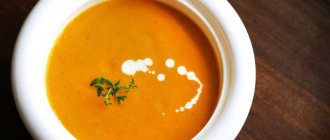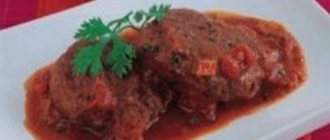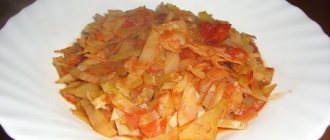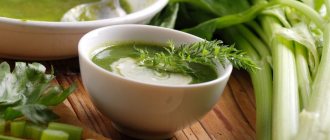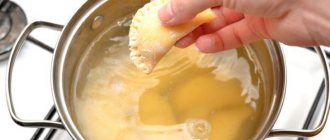Eating vegetables keeps you beautiful and healthy. The composition contains useful substances, the products are easily digestible, accessible and easy to prepare. We have collected for you recipes for the best vegetable dishes that will decorate the table and help you build your dream figure!
The benefits of the products can hardly be overestimated. By including vegetable dishes in your diet, you get many benefits:
- ease of absorption without overloading the gastrointestinal tract;
- saturating the body with vitamins, fiber, minerals;
- long-term preservation of a feeling of satiety.
Vegetable dishes are found in kitchens all over the world and are indispensable in a vegetarian diet, during fasting, or on a diet. Experienced and novice athletes should have dietary recipes made from plant foods in their arsenal.
In this article you will learn the most popular, delicious and easiest to follow vegetable recipes.
The benefits of vegetable soups for weight loss
A diet based on stewed vegetables allows you to gradually lose excess weight, which will not return after losing weight. Beneficial qualities of vegetable stews:
- Minerals and vitamins. Proper stewing preserves all the beneficial qualities of raw fruits.
- Low energy value. Stewing with little or no oil does not increase the calorie content of raw vegetable fruits.
- Impressive fiber content. Fiber corrects metabolic processes in the body, promoting the removal of toxins and weight loss.
- Low carbohydrate content. When losing weight, this quality is valuable because stewed vegetables do not burden the liver.
- Volume of consumption. Stewed vegetable fruits can be eaten in large quantities. It is only important to correctly combine the ingredients in the finished dishes.
Consumption of first courses when losing weight has the following advantages:
- They are low in calories, because... Almost no fat is used during the cooking process. Thanks to their liquid consistency, soups are digested better and faster.
- It takes little time to cook, so the vegetables retain most of their nutrients.
- Soup ingredients contain coarse fibers, which improve the functioning of the gastrointestinal tract and cleanse it. Fiber gives you a feeling of fullness for a long time.
- They contain water, so their regular use normalizes the water balance.
Vegetable soups are very useful for losing weight.
What vegetables are used for weight loss
The purpose of the vegetable diet:
- getting rid of extra pounds;
- cleansing the intestines of gases and rotting products;
- removal of toxins;
- improvement of health in case of stomach problems, cardiovascular diseases and atherosclerosis;
- enriching the body with vitamins and microelements.
The main benefits for weight loss come from: carrots, pumpkin, onions, broccoli, cabbage, tomatoes, celery and lettuce. Fresh fruits rich in fiber provide nutrients to the body, but due to their low calorie content, a person does not gain weight.
The leaders in fiber content are carrots, broccoli, white cabbage, and legumes.
While following a vegetable diet, you should consume less foods containing starch and significant amounts of sugar: pumpkin, potatoes, peas and corn. But asparagus, artichoke and celery can be enjoyed in large quantities.
The highest content of vitamins and beneficial microelements is found in: broccoli, beans, carrots, lentils, greens, cucumbers and asparagus. These products from the garden are given a special place in the daily diet.
The best vegetables for your diet
People who want to lose weight often ask: is it possible to eat stewed vegetables on a diet? Not only is it possible, but it is necessary! Losing weight on stewed vegetables will be effective if you know what to use. The best for diet are:
- Green bean. The composition contains magnesium, iron, folic acid, protein. 100 g of food contains 24 kcal.
- Tomatoes. Lycopene, found in the food, accelerates digestion and breaks down fat (23 kcal/100 g).
- Asparagus. Removes fluid, eliminates cellulite (19 kcal/100 g).
- Cabbage (Peking cabbage, broccoli). Tartronic acid inhibits the accumulation of fat deposits (25 kcal/100 g).
- Stem celery. Contains zinc, phosphorus, vitamins C, A, E, potassium. Accelerates calorie burning (13 kcal/100 g).
- Eggplant. Rich in potassium, organic acids, pectin, which prevents fatigue during the diet (24 kcal/100 g).
- Carrot. Contains antioxidants, more than 10 vitamins (33 kcal/100 g).
- Zucchini. Corrects the water-salt balance, which is important for weight loss (24 kcal/100 g).
- Bell pepper. Reduces appetite, accelerates metabolism (27 kcal/100 g).
- Cucumber. The composition contains iodine, potassium, fiber, which improves the functioning of the gastrointestinal tract (13 kcal/100 g).
- Spinach. Contains carotene, iron. Enhances metabolism (20 kcal/100 g).
Beans stewed with bell pepper
Ingredients:
- – 2 tbsp. red beans,
- – 2 bell peppers,
- – 2 carrots,
- – 2 cloves of garlic,
- – 3 laurel leaves,
- – 350 g tomatoes,
- – half a red onion,
- – 1 tbsp. l. olive oil,
- – 1 tsp. curry,
- – 1 tsp. paprika,
- – 1 tsp. oregano,
- – salt to taste,
- – ground black pepper to taste.
How to cook at home
- Soak the beans in water overnight. In the morning, drain the water, rinse the beans, fill with clean water, add laurel and cook until soft for an hour.
- 15 minutes before the beans are ready, start preparing the vegetable sauce. Cut the onion into cubes, garlic into thin slices, and carrots into slices.
- Heat olive oil in a frying pan. First fry the onion and garlic. When the onion becomes transparent, add the chopped carrots.
- Fry the carrots for three minutes. Then add the tomatoes, diced and peeled. Sprinkle with salt and spices. Stir and simmer the tomato sauce for 10 minutes under the lid.
- Peel the pepper from seeds and cut into large squares. Add chopped peppers and boiled beans to the tomato sauce at the same time. Pour in a little bean broth, it is necessary for stewing.
- Mix. Let's simmer everything together for another fifteen to twenty minutes. During this time, the pepper will become soft, and the beans will be saturated with the aromas of spices, tomato sauce and sweet pepper.
- Serve the flavorful stewed beans with bell peppers hot as a main dish. You can decorate with fresh herbs to taste.
General rules
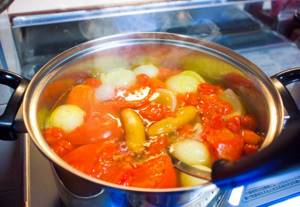
A diet of stewed vegetables will only be beneficial if you follow the basic rules of dietary nutrition:
- You should avoid eating salt. If you do not have this opportunity, salt the dish after making it.
- You can eat up to 1.5 kg of stewed vegetables per day. Divide this amount evenly into 5-6 doses.
- Stay hydrated. You should drink 2 liters of liquid per day (rose hip decoction, herbal tea, water).
- Be sure to minimize the fat content (or complete absence) in prepared foods. To do this, eliminate the addition of sour cream, mayonnaise, and reduce the amount of oil.
- Limit your consumption of beets, onions, and turnips.
- Use the optimal combination of vegetables in your daily diet to provide your body with the right amount of vitamins. Be sure to add greens to the prepared dish.
- Eat food warm, not hot or cold.
- If you plan to stick to the diet for more than a week, add protein dietary products (chicken breast, lean fish, cottage cheese) to it.
A vegetable diet is a low-calorie express diet and allows you to reduce body weight in a short period of time. The importance of vegetables in human nutrition cannot be overestimated, since their absence in the diet does not provide the body with physiologically adequate nutrition. The nutritional value of vegetables is determined by their biological composition, which includes a wide range of macro- and micronutrients.
The carbohydrate content in vegetables varies from 3 to 10%, the maximum amount of which contains carrots (up to 7%) and beets (up to 10.8%). Carbohydrates in vegetables are represented mainly by complex carbohydrates (pectin, starch, fiber) and to a lesser extent by simple carbohydrates - sugars in the form of glucose (pumpkin, cabbage, cucumbers) and sucrose (carrots, onions, beets). Vegetable crops with a high starch content include potatoes, legumes, and root vegetables.
The benefits of vegetables are also due to their high fiber content, which helps remove cholesterol from the body, improve peristalsis and normalize the intestinal biocenosis. Vegetables are rich in vitamins (B1, B6, K, P, ascorbic acid, folic acid, rutin) and micro/macroelements (sodium, potassium, phosphorus, iodine, copper, cobalt, calcium, manganese, molybdenum, sulfur).
Thus, parsley leaves, onions, green peas, parsnips and cabbage contain a lot of phosphorus; root vegetables and leafy vegetables - potassium; cauliflower, salads, garden greens, spinach - calcium; cucumbers, beets, lettuce and tomatoes - iron. Vegetables also play an important role as a source of plant proteins.
In general, vegetables and dishes made from various vegetables cover a significant part of the body’s need for water-soluble vitamins, maintain acid-base balance, stimulate the secretion of gastric juice and bile formation, motor function of the gastrointestinal tract, improve the absorption of animal proteins, fats and carbohydrates, allow you to diversify the diet and stimulate appetite .
| Product name | Calorie content of fresh vegetables (Kcal per 100 g) |
| White cabbage | 27 |
| Cauliflower | 32 |
| Brussels sprouts | 44 |
| Broccoli | 34 |
| Kohlrabi | 42.6 |
| Carrot | 37 |
| Eggplant | 24.8 |
| Zucchini | 25 |
| Bulb onions | 41 |
| Green peas | 74 |
| Bulgarian pepper | 27 |
| Ground cucumbers | 14 |
| Potato | 81 |
| Radish | 35 |
| Tomatoes | 22 |
| Parsley greens | 48 |
| Beet | 42 |
| Celery (root) | 32 |
| Garlic | 46 |
| Leaf lettuce | 16 |
| Pumpkin | 25 |
| Dill | 31 |
| Sorrel | 19 |
| Radish | 21 |
A vegetable diet allows the inclusion of many vegetables in the menu, with the exception of vegetable crops rich in starch (potatoes, corn, squash, radishes, pumpkin, radish) and reduced consumption of moderately starchy vegetables (carrots, turnips, beets, eggplants, zucchini, soy). Potatoes can only be used baked.
Vegetables can be consumed raw and in the form of boiled, steamed and stewed dishes. When preparing dishes, it is recommended to combine several vegetables in one dish and actively use garden herbs. You can prepare smoothies based on them and include freshly squeezed juices in your diet.
To lose weight, you can use various options for a vegetable diet, both strictly vegetable and more gentle options (protein-vegetable and fruit-vegetable). A strict version of the diet provides for the presence in the diet of only permitted vegetables in the amount of 1.5-1.8 kg/day, which are divided into 5-6 meals.
The amount of free liquid is 1.5-2.0 l/day, in the form of rosehip decoction, still mineral water, vegetable juice, unsweetened green or herbal tea. This diet option has a low calorie content, about 900-1200 Kcal/day and is extremely unbalanced - the body receives practically no proteins and fats.
The duration of such strict diet options should not exceed 3 days. Longer periods of stay on such a diet increase the risk of developing protein starvation and a deficiency in the supply of unsaturated fatty acids and fat-soluble vitamins. In addition, such a diet is very stressful for the body.
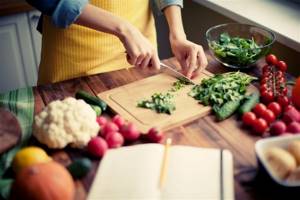
For longer periods (7-15 days), protein-vegetable diets are recommended, the diet of which is expanded to include foods containing protein - lean fish, dietary meats, cottage cheese, chicken eggs, low-fat fermented milk products, dried grain bread. At the same time, you can use all of these products, or only one of them, for example, chicken breast or fish.
Products containing protein are included in the diet only in boiled, steamed or stewed form and in small quantities (up to 200 g/day). With any diet option, salt and sugar, animal and cooking fats, baked goods, sweets, and alcohol are excluded. It is advisable to take vitamin-mineral complex tablets.
In general, vegetable-based weight loss diets have a number of significant disadvantages. The diet is physiologically deficient in macro- and micronutrients, which can cause weakness and a decrease in overall performance, concentration, and slower reactions. Eating large amounts of vegetables and especially cabbage can cause fermentation in the intestines with pain and flatulence. The diet is psychologically difficult to bear.
When following a diet for more than 7 days, the correct exit from it is extremely important:
- Expand your diet and increase portions gradually. First, introduce red lean meats, seafood, red fish, cheeses, and dried bread into your diet. Continue to include enough vegetables in your diet. Eat fermented milk products for dinner. Drink enough fluids.
- After 3-5 days, introduce foods containing simple carbohydrates into the diet (honey, jams, preserves, small amounts of sugar) and even later - sausages, white bread, smoked meats, fatty and fried foods. Don't overeat.
Shish kebab of champignons on the grill

Products:
- – champignons – 1 kg.,
- – soy sauce – 1 glass,
- – ground black pepper – 0.5 tbsp.,
- – ground red pepper – 0.5 tsp,
- – paprika – 0.5 tsp,
- – onions – 2 heads,
- – ground coriander – 1 tbsp.,
- – olive oil – 4 tbsp.,
- – garlic – 4-5 cloves.
How to cook at home
- 1. To prepare mushroom kebabs, take fresh champignons. The mushrooms must be young. Mushroom caps should not expose the space between the stem and cap. The caps are pressed tightly to the legs. The mushroom practically does not accept moisture. Champignons that have been sitting will be withered. It is better to take 1-2 days. Wash the mushrooms and allow excess liquid to drain.
- 2. Transfer the mushrooms to a container. I have quite large mushrooms. These are the ones you need to take. Mushrooms that are too small are difficult to skewer. The mushroom cracks and tears. The fungus should be a decent size. Pour soy sauce into the container and add the mushrooms.
- 3. Now add spices to taste. Pass the garlic through a press. Mix mushrooms with spices and garlic. Pour in olive oil. Stir again. The oil will allow the spices to penetrate the mushroom and soak the mushrooms in the marinade.
- 4. Cut the onions into rings. Add to mushrooms and stir. Close the container with a lid and leave the mushrooms to marinate for 3-4 hours. The mushrooms will be marinated in the refrigerator. Ideally, leave the mushrooms in the marinade overnight.
- 5. Prepare the coals on the grill. The coals should not burn. We need heat, not flame. Thread the marinated mushrooms onto skewers, alternating with onion rings.
- 6. Place the skewers with mushrooms on the grill. Simmer the mushrooms on the grill until cooked, periodically turning the skewer so that the mushrooms are browned on all sides. General frying takes a few minutes.
- 7. Remove the mushrooms from the grill and serve.
Features of stewing vegetables
So how to stew vegetables correctly when on a diet? Vegetables prepared by stewing will help you lose excess weight only if they are prepared correctly. To do this, consider the following cooking specifics:
- Simmer the vegetables over low heat in a container covered with a lid.
- Cook using the oven, slow cooker, microwave, steamer or on the stove. Extinguishing with steam preserves the cellular structure of the food.
- Cook food in thick-bottomed, high-quality steel containers. This will preserve all the beneficial qualities of vegetables.
- Carry out heat treatment for no more than 40 minutes. If the dish is cooked longer, the amount of vitamins in it will decrease.
- Prepare the ingredients correctly. Finely chop the cabbage, and cut the zucchini, tomatoes, and cucumbers into cubes with a stainless steel knife.
- Do not add too much water as it will dissolve the beneficial components. When stewing, vegetables themselves release excess liquid. As a result, the food will be cooked in its own juice.
- You can stew both fresh and frozen vegetables. Defrost the latter naturally.
Lenten pilaf with vegetables
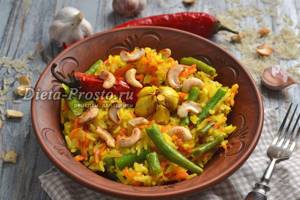
Ingredients:
- – long steamed rice – 200 g;
- – onion – 110 gr.;
- – carrots – 150 gr.;
- – dried carrots – 30 gr.;
- – green beans – 400 gr.;
- – garlic – 1 head;
- – chili pepper – 1 pod;
- – sunflower oil – 50 ml;
- – ground turmeric – 4 g;
- – cashews – 100 gr.;
- – salt, cumin, mustard seeds.
How to cook at home
- Let's prepare the products. Finely chop the onion.
- Peel fresh carrots and chop into thin strips.
- Soak long steamed rice in cold water, then rinse several times until the water becomes clear. Place the cereal on a sieve and let the water drain.
- In a thick-bottomed saucepan or cauldron, heat odorless sunflower oil, add the chopped vegetables, reduce the gas, and sauté the vegetables over moderate heat for 10 minutes.
- Then add ground turmeric, a teaspoon each of cumin and mustard seeds, add dried carrots, mix.
- Spread washed rice over vegetables in an even layer.
- Pour 350 ml of cold filtered water, add salt to taste. Pour in the water carefully, in a thin stream, to keep the rice layer even.
- Remove several layers of peel from the head of garlic. Prick the chili pepper with a knife in several places. Place the garlic and chili in the pan, close the lid tightly, and cook over low heat for 25 minutes.
- 10 minutes before readiness, pour frozen green beans onto the pilaf, close the pan tightly again, and cook over low heat.
- Remove the finished pilaf from the stove, wrap it in a towel, and leave for 20 minutes.
- Stir, sprinkle with roasted cashew nuts and serve immediately.
- Bon appetit.
How to cook vegetables on a diet
Vegetables promote weight loss. It is important to cook them correctly when eating a vegetable diet. Not only their benefits, but also the availability of calories depends on how the fruits from the garden are prepared.
Roasted vegetables are considered less healthy and high in calories compared to other food processing methods. If the oil used for frying is of poor quality, carcinogens will be released during cooking. Also, fried vegetables increase calorie content by up to 200 kcal.
As an alternative to fried vegetables, steamed or baked ones are perfect.
Vegetables baked in the oven will not add extra calories, but will still taste good and have an appetizing crispy crust. For more aroma and piquant taste, you can add spices.
Vegetables steamed or stewed in a frying pan are also tasty and healthy. At the same time, there are many recipes for various vegetable dishes, steamed or stewed, since the ingredients can be combined in various ways.
Vegetables on skewers in the oven
Multi-colored kebabs will easily decorate any table - a home dinner or a festive meeting with friends. It is easy to include any vegetable or product in their composition.
Ingredients:
- Multi-colored bell peppers - half of three different peppers;
- Zucchini – 1 pc.;
- Potatoes – 5 pcs.;
- Butter – 1 tbsp.
- Garlic – 2-3 cloves;
- Rosemary and oregano - half a teaspoon each;
- Wooden skewers;
- Pink Himalayan salt.
Preparation:
- Prepare all required ingredients in advance.
- Wash the vegetables thoroughly and dry.
- Boil the potatoes until half cooked in slightly salted water. Drain the water, cool and cut into circles.
- Cut the zucchini into slices.
- Cut the pepper into squares.
- Salt the zucchini pieces and let sit for 10 minutes.
- The butter must be melted until soft.
- Cut each clove of garlic in half.
- Take turns stringing zucchini, potatoes, and bell peppers onto a skewer several times to create a multi-colored kebab.
- Using a pastry brush, brush each kebab with softened butter.
- Sprinkle dry aromatic herbs and a little pink salt on top.
- Line a baking dish with baking paper.
- Place garlic around the perimeter.
- Place the kebabs side by side.
- Bake in an oven preheated to 200 degrees for about 30 minutes. Readiness is determined by the appearance of a golden crust on the sides of the potatoes.
Vegetable recipes
To make the menu varied, here are recipes for delicious dietary dishes.
Required:
- fresh beets and carrots 2-3 pcs.;
- garlic 2 pcs.;
- vegetable oil 15 ml;
- greenery.
Recipe:
- Wash, peel and grate vegetables.
- Chop the greens.
- Chop the garlic.
- Mix all ingredients.
Add the dressing before eating the salad.

While following a vegetable diet, you must drink at least 2-3 liters of water per day.
You can use any vegetables, herbs, garlic. Step by step steps:
- Chop the ingredients.
- Simmer them until the liquid evaporates and the juice releases (about half an hour).
- Chop the garlic and herbs and add to the stew after turning off the stove.
- Before use, add a couple of drops of oil.
Animal fats and salt should not be used.
Stew cooked in a slow cooker retains all the beneficial vitamins and nutritional properties of vegetables. For this dish you will need the following ingredients:
- eggplant – 1 pc.;
- zucchini – 1 pc.;
- tomatoes – 3 pcs.;
- carrot – 1 pc.;
- white cabbage – 0.5 kg;
- onion – 1 pc.;
- salt, spices - add to taste.
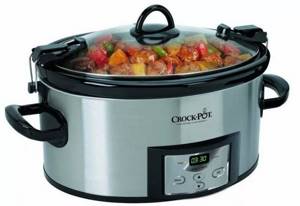
First, peel all the vegetables and rinse them under the tap. Next, cut the ingredients into equal cubes and place them in the multicooker bowl. Cook for approximately 60 minutes with the “Stew” mode activated.
5 minutes before final readiness, pour salt and spices into the bowl. Let the finished dish sit for about 1 hour. The finished stew should be served with greens, low-calorie omelettes, etc.
Vegetable dishes for weight loss are relatively simple and do not require any special cooking skills or knowledge. Dietary vegetable dishes for weight loss are quite numerous, and using them in various combinations and many ways of cooking vegetables allows you to diversify the menu as much as possible - these include vegetable soups, dietary stewed vegetables, a variety of salads that use a lot of vegetables, cabbage cutlets, vegetable pilaf, casserole.
Let's find out how to stew vegetables while on a diet. To create this dish, no preliminary preparations are required; it is simply prepared. All vegetables can be grown in your own garden plot, and then lunch will be even healthier. To reduce calorie content, you can exclude vegetable oil from the dish and add less potatoes, that is, make zucchini the base vegetable. We take:
- two carrots;
- 6 potatoes;
- one zucchini;
- large onion;
- 3 sweet peppers;
- 2-4 tbsp. l. ketchup or tomato paste;
- greens (to taste);
- dry pepper;
- vegetable oil for frying;
- salt.
Many nutritionists claim that the health benefits of vegetables depend on the way they are prepared. Stewed vegetables when losing weight allow you to achieve a slim figure. Thanks to this processing method, all vitamins are preserved in vegetables.
It is very pleasant to be on such a diet if you cook your favorite dishes. You can cook up stews or unusual, mouth-watering treats that will help you lose weight. If you supplement your diet with such foods, you will definitely become an active and healthy person. An approximate list of foods for the diet looks like this:
- cabbage stewed with turmeric;
- beans stewed with bell pepper;
- pumpkin puree with cauliflower;
- stewed frozen vegetable mixture with beans;
- assorted vegetables from cabbage (white, cauliflower or Brussels sprouts) with the addition of carrots.
For a diet, stewed zucchini with vegetables is best suited. You will need:
- tomatoes – 3 pcs.;
- carrots – 3 pcs.;
- 4 zucchini;
- a pair of onions;
- 3 cloves of garlic;
- 2 bay leaves;
- a bunch of dill;
- olive oil;
- salt;
- freshly ground black pepper.
Dietary vegetables
Juicy and delicious vegetables baked in your home oven are perfect for all gourmets who follow a strict diet. The dish turns out incredibly tasty and very low in calories. Spicy and aromatic spices enhance the taste and make it incredibly piquant.
They can be a good addition to dietary food (meat, steamed cutlets, light soup) or become a separate diet.
To prepare this easy and tasty casserole, you need to prepare your workspace and prepare all the necessary ingredients:
- tomatoes (250 gr);
- homemade eggplants (250 gr);
- fresh zucchini (250 g);
- onions (one medium head);
- sweet pepper with thick walls (250 g);
- olive or vegetable oil (2 tablespoons);
- balsamic vinegar (2 tablespoons);
- medium-sized carrots (2 pcs.);
- garlic (one head);
- salt;
- spices.
Attention! The dish is dietary. Therefore, it is strongly recommended not to add mushrooms or other heavy foods there. They will harm the stomach and slow down healing.
Let's start cooking. First you need to wash all the fruits and grease the baking sheet. Lay out the ingredients one by one.
1. Zucchini and eggplant are cut exactly the same. Remove the skin and cut into large pieces.

2. Chop the onion into medium pieces.
3. Remove the back part and seeds from the bell pepper. We cut it into oblong pieces.
4. Cut the carrots into large rings (2 – 3 cm).
5. Chop the tomatoes into large slices.
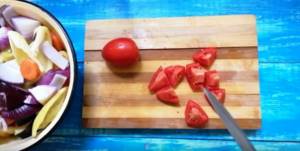
6. Prepare the sauce. Mix balsamic vinegar, spices and oil. Everything is prepared in a small container. The components must be thoroughly mixed into a thick paste.
7. Place all vegetables on a baking sheet. Do not cut the garlic, peel it and lay it out whole.

8. Mix the entire consistency and send it to our oven to simmer at a temperature of 200°C. The baking tray with the slices should remain inside for about 40 - 45 minutes.
The color of the fruit remains virtually unchanged. Diets have never been so enjoyable and nutritious.
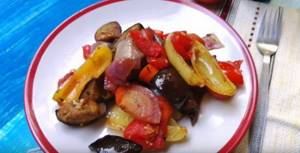
How to cook?
Have you decided to go on a diet? Implement the recipe for stewed vegetables like this:
- First, peel and chop the onion.
- Place the chopped onion in a hot frying pan with vegetable oil.
- Peel the carrots and grate them. When the onion becomes transparent, add the carrots.
- Stir the vegetables, lightly fry, then add tomato paste to them. Make sure that the mixture does not burn. If you did not add vegetable oil, pour in a little water.
- Wash the pepper, peel and cut into thin strips. Place in the pan with the rest of the vegetables.
- Peel and seed the zucchini. Cut the pulp into thin slices.
- Place the zucchini in the frying pan, cover with a lid, reduce heat and simmer, stirring frequently.
- While the zucchini is simmering slightly, peel the potatoes, cut into small slices and add to the vegetables.
- Stir all the vegetables, cover and simmer over low heat for 30 minutes. During this time the potatoes should be cooked.
- Next, salt the dish, pepper, add chopped herbs.
Now you know how to properly stew vegetables while on a diet. The dish made in this way goes perfectly with fresh tomatoes or cucumbers. Be sure to add fresh chopped dill or parsley. The composition of the dish can be changed depending on what products you have. You can add eggplant, cabbage, pumpkin.
Vegetables in the oven, baked in large pieces
Baking vegetables in large pieces helps preserve most of the microelements and vitamins in each of them and protects them from drying out. The dishes remain juicy, with the preserved taste of each individual vegetable. This is an excellent choice for those who prefer vegetarian or dietary nutrition.
The absence of frying relieves the body of the hard work of digesting such food and its further elimination; all microelements are easily absorbed without being subjected to an aggressive attack by overheated fats.
Preparation and total time costs – 55-60 minutes.
The amount of ingredients is indicated for 3 servings.
What you will need to complete the dish:
- Zucchini – 1 piece (you can use zucchini);
- Eggplant – 1 piece;
- Bulgarian sweet pepper – 1 piece;
- Tomato – 5 pieces. It is better to use varieties containing more pulp and less juice;
- Favorite greens to taste – 3-4 sprigs;
- garlic - 3 cloves;
- Vegetable oil – 2 tablespoons;
- Salt, ground black pepper.
Prepare the required set of products. Everything should be at hand.
- Rinse the vegetables well, dry them, remove the stems.
- Cut the eggplant and zucchini lengthwise and cut each half into half rings approximately 1-1.5 cm wide.
- Cut the tomato into 4 parts.
- Peel the sweet pepper from seeds and cut into large pieces.
- Chop the garlic cloves into thin slices.
- Place all chopped ingredients in a deep bowl. Add salt, hot pepper and spices. Add vegetable oil and everything is fine, but mix gently.
- Place foil in a baking dish. Arrange the prepared vegetables evenly on it. Cover the top with foil.
- Preheat the oven to a temperature of 200 degrees. Place a baking tray or mold in it.
- Bake for about an hour. When the first thirty minutes have passed, open the foil and the vegetables will begin to brown.
- Serve after sprinkling with chopped herbs.
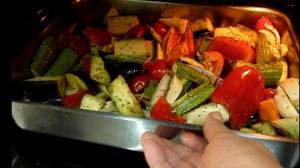
Cooking process
So, follow these steps:
- Peel the carrots, onions and garlic. Grate the carrots on a coarse grater, chop the garlic, and cut the onion into cubes. Place the tomatoes in boiling water for 2 minutes, then rinse with cool water and remove the skins. Cut the tomatoes into small cubes.
- Heat a frying pan with olive oil over medium heat. Add onion and garlic and fry until soft for 5 minutes. Then add the carrots and cook for another 7 minutes. Then add tomatoes to the vegetables and fry for 10 minutes. Pepper and salt everything.
- If the zucchini has a thick skin, peel it. Cut the zucchini into 6mm thick slices.
- Pour a little olive oil into the bottom of a heavy saucepan. Place a layer of zucchini and lightly salt. Then make a layer of fried vegetables, and then another layer of zucchini. Alternate layers until all ingredients are gone. Place the bay leaf in the pan, cover with a lid and place over moderate heat. Boil the dish and simmer for half an hour.
Transfer vegetables to a platter, being careful to maintain layers. Crush with chopped dill and start your meal.
Vegetables baked with cheese and sour cream
The calling card of this recipe is a cap of sour cream and grated cheese on baked vegetables. It seals all the most delicate aromas and keeps vegetables juicy and appetizing.
Ingredients:
- Broccoli – 350 grams;
- Cauliflower – 350 grams;
- Zucchini – 1 piece;
- Eggplant – 1 piece;
- Bell pepper – 2 pieces (different colors for brightness of the final dish);
- Potatoes – half a kilogram;
- Tomatoes - half 1 kg (preferably cherry);
- Carrots – 2 pieces;
- Onions – 2 pieces;
- Green peas (canned or fresh) – 150 grams;
- Sour cream 15% - 200 grams;
- Sunflower oil – 2-3 tbsp;
- Cheese – 300 grams;
- Spices – which ones do you use?
- Salt and black pepper.
Preparation:
- Wash all vegetables thoroughly.
- Cut the eggplant into large circles, add salt, place in a container and leave for half an hour. This is done so that the bitterness goes away.
- Separate both types of cabbage into inflorescences.
- Trim the ends of the zucchini and cut into large pieces. If necessary, remove seeds.
- Coarsely chop the onion.
- Young potatoes do not need to be peeled, just rinse thoroughly with a sponge. Chop coarsely too. Leave small tubers whole.
- Remove the seeds from the pepper and chop coarsely.
- Cut the cherry in half. Cut tomatoes of another variety into four parts.
- Place all prepared vegetables in a deep bowl. Add salt. Spice up. Add aromatic spices or Provençal herbs. Drizzle with vegetable oil and sour cream. To stir thoroughly.
- Grease a baking dish or baking sheet with oil. Place prepared vegetables on the bottom.
- Sprinkle green peas on top.
- Bake vegetables in an oven preheated to 200 degrees for 30 minutes.
- Grind the cheese on a coarse grater.
- After half an hour, take out the form with vegetables and sprinkle with grated cheese. Return to oven. For another 10-20 minutes.
A light dietary dish is ready. Serve hot.
Zucchini diet
Zucchini is an incredibly healthy vegetable that is common in the spring and summer. It contains the most important microelements (calcium, magnesium, iron, potassium, etc.) and vitamins (PP, A, groups B, C, E).
The essence of the diet: for seven days you should eat zucchini dishes, lean poultry and fish, low-fat yogurt and cottage cheese, milk, eggs, mushrooms and herbs are allowed. Salt can be used in small quantities. Pasta and bakery products, fats, potatoes, sugar, smoked products, pickles, coffee and alcohol are strictly prohibited.
To create dishes, it is better to take young zucchini, mainly zucchini (with dark green skin). Only very young zucchini can be eaten raw.
It is better to cook this vegetable with the peel, which contains a basic amount of nutrients. Cooking time should be minimal. During the diet, meals should be quite plentiful and five times a day.
This diet is not suitable for:
- teenagers during puberty;
- lactating and pregnant women;
- people suffering from chronic diseases of the urinary system and kidneys (due to the impressive potassium content, the load on the kidneys will increase and the patient’s condition will worsen).
Sample menu:
- Breakfast. Stewed zucchini with vegetables (any kind except potatoes) in the proportion of 2/3 zucchini, 1/3 vegetables (total weight - up to 0.6 kg) and a glass of tea without sugar (preferably green or black leaf).
- Lunch. An apple (can be replaced with a fruit other than grapes or banana) and a glass of water or fresh juice.
- Dinner. Lean boiled poultry (200 g), baked zucchini (300 g), one kiwi or two plums and a glass of tea.
- Afternoon snack. One apple, raisins (100 g), a glass of orange juice.
- Dinner. Stewed zucchini, cabbage and carrot salad, seasoned with lemon juice and olive oil, a cup of tea or a glass of orange juice.
If you decide to extend the zucchini diet for more than 7 days, start taking vitamin supplements.
This diet allows you to lose 3 to 5 kg of excess weight in a week. And if you also play sports, the result will be much better. Nutritionists advise using this diet once a year, since zucchini is a seasonal vegetable.
Spinach stewed with potatoes
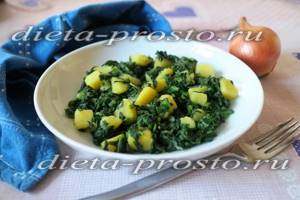
Ingredients:
- – 300 gr. spinach,
- – 1 large potato,
- – a quarter of a large onion,
- – 0.5 tbsp. olive oil,
- – salt to taste,
- – black pepper to taste.
How to cook at home
- Heat olive oil in a frying pan. Chop half an onion into rings. Fry the onion in oil, stirring until it becomes transparent and fragrant.
- Peel the potatoes and cut them into large cubes. Place in a frying pan and fry along with the onion for five minutes. Pour in a little water so that the potatoes do not stick to the surface, because we use a small amount of oil.
- While the potatoes are stewing, thoroughly wash the spinach leaves. Shake off any drops of water and chop the spinach not very finely.
- When the potatoes have softened, add chopped spinach to the pan. Mix it with potato pieces, salt and pepper to taste.
- Simmer everything together for 7-8 minutes under the lid until the spinach and potatoes are completely cooked. If necessary, add a little more boiling water to simmer.
- Serve sautéed spinach with potatoes and onions as a main course. By the way, such a lunch will perfectly diversify the menu on fasting days.
Vegetable diet for weight loss: reviews and results
Reviews of those who have lost weight on vegetables, as well as the results, differ significantly.
- “...Together with my friends before the vacation I went on a strict vegetable diet. She only lasted less than three days. Although they wrote that hunger was barely felt, I wanted to eat all the time. On the 3rd day, the intestines became swollen from rough food, and I stopped torturing myself. I will look for other diets"
- “... I’ve been using a vegetable fasting day once a week for almost 10 years. Very pleased. Feeling better, the body is cleansed well”;
- “... I go on this diet every year, towards the end of summer, when a large assortment of vegetables is on sale. As a rule, for a week, sometimes 10 days, but I practice a mixed protein-vegetable diet. I'm happy with the results: 6-10 kg per week. I feel great, good skin color, I recommend it to everyone.”
What reviews do people who are losing weight (or have already lost weight) leave about the diet based on stewed vegetables? Many people say that they like stewed vegetables better than raw ones. These people also note that this diet is good for health. After all, for those who have stomach problems, it is better to stew vegetables. Are you still asking whether you can eat stewed vegetables on a diet? As you can see, having studied the reviews of those losing weight, this question can only be answered positively.
Some women claim that they usually stew a pot of vegetables and eat it all day with pleasure. Some say that they were able to lose 5 kg of excess weight in a week, others – 4 kg.
Many women note that stewed vegetables bring triple benefits: weight loss, pleasure and benefits for the stomach. Some people write that every summer they eat only zucchini dishes. As you can see, everyone likes a diet based on stewed vegetables, since you can easily lose weight with it.
Eggplants with walnuts in sweet pepper sauce

Ingredients:
- – 1 large eggplant,
- – 1 red bell pepper,
- – 3 cloves of garlic,
- – a handful of walnuts,
- – a sprig of parsley (or other herbs),
- – salt to taste,
- – black pepper to taste,
- – 0.3 tsp. curry.
How to cook at home
- Remove the seeds from the sweet pepper. Wash the eggplant and cut into quarters. Not very thin, about 0.5 cm thick. Place the eggplant pieces on a wire rack, add salt and place in the oven to bake for 15 minutes at 180 degrees.
- Cut the pepper into several pieces and bake together with unpeeled garlic cloves in the oven at the same temperature, but longer, for half an hour.
- Cool the finished pepper slightly and remove the burnt skin. Squeeze the baked garlic from the husk. Place the peppers and garlic in a blender bowl.
- Puree the baked peppers and garlic using an immersion blender until smooth.
- Peel the walnuts and chop them quite finely with a knife. Wash and chop the parsley.
- Pour the resulting pepper and garlic sauce into a frying pan, add salt, season with spices and heat (bring to a boil).
- When the sauce boils, add the previously baked eggplant pieces. Mix the eggplant with the sauce.
- Add chopped nuts and herbs and mix.
- Warm everything together for another minute or two, then remove from heat.
- Serve balkzhans in pepper sauce with walnuts hot as a second course or side dish. You can additionally sprinkle each serving with chopped herbs. By the way, if you let this dish brew, it becomes even tastier and richer.


